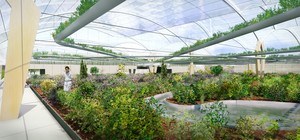SIGN (Dutch Foundation for Innovation in Greenhouse Horticulture)
The Dutch Foundation for Innovation in Greenhouse Horticulture (SIGN) is a non-profit organisation. The SIGN1 Foundation works with the ministry of Agriculture, Nature and Food on ground-breaking system innovations in horticulture. The aim is to contribute to a vital, sustainable and socially valuable greenhouse horticulture in 2030.
SIGN develops powerful innovation perspectives with a long term vision and short-term perspectice so as to inspire and bring the sector into movement.
The Foundation is financed through government and private funds of the Dutch greenhouse sector on an equal basis (50 / 50%). Because of these funding sources, reporting is mainly in Dutch. Some publications have an English summary.
Several of our programmes are of international importance, specifically:
- iGreen Plant bag (backpack)
- Lightweight floating systems
- WorkisGaming
- Polydome (High Productive Polyculture Systems)
- Building with Green and Light
- Wikiplant
- Pearls in the Landscape (spatial quality with greenhouses)
- Greenhouse as Energy source
Please contact SIGN at sign@innovatieglastuinbouw.nl for more information or contact one of us directly (see footer).
1. SIGN is an initiative of The Dutch Horticultural Growers Association (Glastuinbouw Nederland)
WorkisGaming: gamification of horticultural labor
WorkisGaming integrates elements from the game industry into workflowmanagement systems creating a modern, attractive work environment. The relationship between employee, employer, and production is more fun, challenging, and smarter.
Polydome (High Productive Polyculture Systems)
Polydome was developed as part of a fundamental solution to the world food production in order to achieve higher yields with less environmental impact than conventional agriculture.

In the Netherlands, we have acquired a new understanding of how to use energy, light and heat. SIGN / Innovation Network developed a sustainable programme in close cooperation with the horticultural sector: Greenhouse as energy source. The same techniques from these revolutionary greenhouses can be used to transform buildings from energy consumers into energy providers. Moreover, we can ensure that a great deal of daylight can be introduced into buildings without the negative effects of overheating.
Of course, we want our homes and offices to be both sustainable and comfortable. Plants contribute to comfort by improving indoor air quality. Research shows that plants have a relaxing effect on people and that patients surrounded by plants recover faster.
SIGN / InnovationNetwork initiated the concept of Building with Green and Light in 2006. The first publication sold out quickly and many Dutch architects and real estate developers embraced our new concept. In the BNA Academy (Dutch Architects Union) we train architects to design buildings incorporating the new philosophies from Building with Green and Light.
Now is the time to share our newly acquired knowledge internationally. The book Building with Green and Light - available in English, French, German and Dutch - combines our knowledge on energy techniques with our knowledge of how to use plants for healthier indoor climates. Most of the projects used as examples are Dutch; we hope they will inspire readers to start up new projects that incorporate plants, daylight and sustainable energy solutions.
SIGNaal
You can download the following SIGN newsletters in English:

 Dewi Hartkamp
Dewi Hartkamp

 Vacature
Vacature RSS Feeds
RSS Feeds